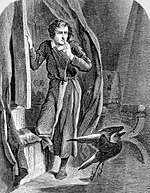
Selected horror profile
Ann Radcliffe (born Ann Ward, 9 July 1764 – 7 February 1823) was an English author and pioneer of Gothic fiction. Her technique of explaining apparently supernatural elements in her novels has been credited with gaining Gothic fiction respectability in the 1790s. Radcliffe was the most popular writer of her day and almost universally admired; contemporary critics called her the mighty enchantress and the Shakespeare of romance-writers, and her popularity continued through the 19th century. Interest has revived in the early 21st century, with the publication of paperback reprints and three biographies.
Radcliffe published five novels during her lifetime, which she always referred to as "romances"; a final novel, Gaston de Blondeville was published posthumously in 1826. At a time when the average amount earned by an author for a manuscript was £10, her publishers, G. G. and J. Robinson, bought the copyright for The Mysteries of Udolpho (1794) for £500, while Cadell and Davies paid £800 for The Italian (1797), making Radcliffe the highest-paid professional writer of the 1790s. Selected horror work
"The Raven" is a narrative poem by American writer and poet Edgar Allan Poe first published in January 1845. Noted for its musicality, stylized language and supernatural atmosphere, it tells of a talking raven's mysterious visit to a distraught lover, tracing his slow descent into madness. The lover, often identified as a student, is lamenting the loss of his love, Lenore. The raven, sitting on a bust of Pallas, seems to further instigate his distress with its repeated word, "Nevermore." Throughout, Poe makes allusions to folklore and various classical works. Poe claimed to have written the poem very logically and methodically. His intention was to create a poem that would appeal to both critical and popular tastes, as he explains in a follow-up essay, "The Philosophy of Composition". The poem was inspired in part by a talking raven in the novel Barnaby Rudge: A Tale of the Riots of 'Eighty by Charles Dickens. The first publication of "The Raven" on January 29, 1845 in the New York Evening Mirror made Poe widely popular in his day. The poem was soon heavily reprinted, parodied, and illustrated. Though some critics disagree about the value of the poem, it remains one of the most famous poems ever written.
Horror topics
|


